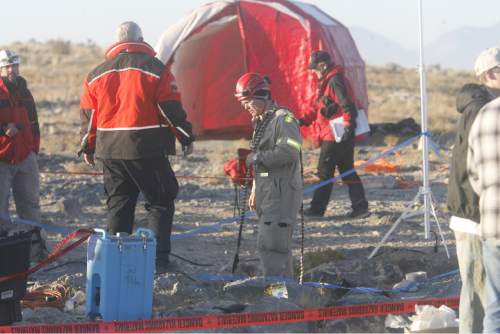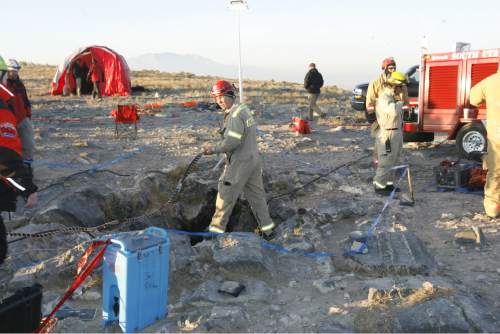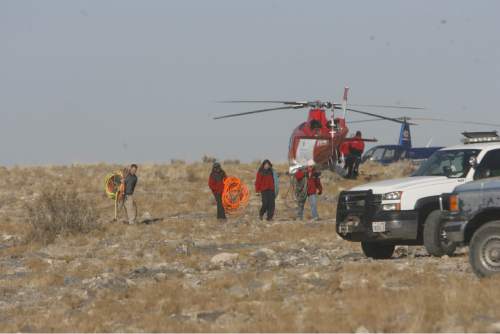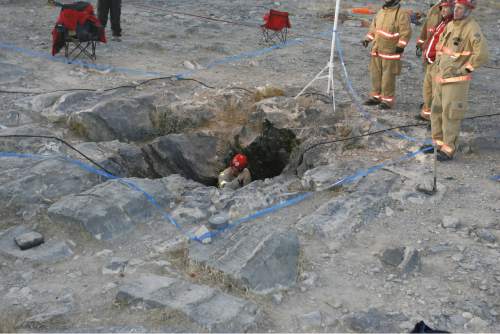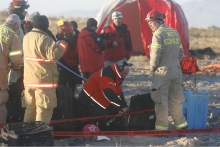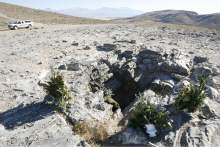This is an archived article that was published on sltrib.com in 2016, and information in the article may be outdated. It is provided only for personal research purposes and may not be reprinted.
When Utah filmmaker Isaac Halasima approached Emily Jones-Sanchez with the idea of making a movie about her late-husband, John Jones — a spelunker who died in the Nutty Putty Cave in November of 2009, after massive but unsuccessful rescue attempts — she wasn't sure what to make of it.
"It had never crossed my mind," Jones-Sanchez said recently. "I wasn't sure how the story could be made into a movie."
After talking it over, discussing the sensitivity of reliving that tragedy, Jones-Sanchez and the Jones family gave Halasima permission.
"We learned some life-changing lessons from the whole experience," Jones-Sanchez said. "We thought that would be worth sharing."
The movie, "The Last Descent," opens Friday in 14 Utah theaters and one in Arizona. The distributor — Salt Lake City-based Excel Entertainment, owned by the LDS Church-operated Deseret Book — aims to release it elsewhere later this year.
Halasima said getting approval from Jones-Sanchez was paramount in making the movie.
"If she said, 'Let's do this,' I'm in," he said. "But if she even hesitated, I wasn't going to do it."
Halasima was working as a film editor in Salt Lake City on Nov. 24, 2009, when he heard the news reports that Jones, a 26-year-old medical student and experienced climber, had gotten stuck in Nutty Putty Cave, just west of Utah Lake.
Halasima, born in Provo and raised in Pleasant Grove, knew Nutty Putty's reputation as a popular spot for spelunkers — and a dangerous one. He had even tried exploring it once. "I'd gone in it, in the front, and kind of said, 'That's it, that's enough,'" he said. A few years later, Halasima — whose past work includes directing music videos for Imagine Dragons, the internationally known rock band that started in Provo — was looking to make his first feature film. The Nutty Putty story came to mind immediately.
"If you want to make an impact, make it about somewhere you know," Halasima said. "For me, it's Utah. It's my home, it's everything I am."
As he researched the story, he learned more about John Jones as a person, which bolstered his resolve to get the movie made.
"It's more than what people see and think, about a poor guy who dies in a cave," Halasima said. "It shows something that can inspire, from a bad situation."
Part of Halasima's research was interviewing Jones-Sanchez about her husband, their courtship and three years of marriage — events the film shows in flashback.
Halasima let Jones-Sanchez read every draft of the script. "He assured us all along the way that if we were unhappy, the movie would never get made," Jones-Sanchez said.
One challenge of writing the story is that many people — especially folks in Utah, who were gripped by the news coverage of the rescue attempt — know the story's tragic outcome.
"It's like 'Titanic,' in that everybody knows the end," Halasima said. "The competitor in me loves that.… Even when you hit the end and they know it, can you make it something they'll never forget? I like that challenge."
Halasima watched movies where the hero dies, such as "Titanic" and "Ghost," to study how they were made.
"The Last Descent" was filmed entirely in Utah. The scenes of the rescue workers' base camp were shot around Nutty Putty Cave, which was sealed after the tragedy with Jones' body still inside. Other caves were used for climbing shots. The interior of Nutty Putty Cave, where Jones was trapped head-down at a 70-degree angle, was re-created in a warehouse in West Valley City.
For the first day of filming, Halasima flew in Jones-Sanchez — who was living in Texas at the time and now lives in Peoria, Ill. — to visit the set. Ironically, Halasima said, the first scene shot was one that comes at the movie's end: The birth of John and Emily's second child, John Jr., born the summer after his father died.
Jones-Sanchez said she was intimidated about meeting Alexis Johnson, the actor who played Emily. "I felt like I was going to meet the prettier version of me," she said.
The two became friends, Jones-Sanchez said, as Johnson asked detailed questions about such things as how she wore her hair. One detail that made it into the performance: When the wardrobe department put Johnson in a sleeveless dress, the actor opted to wear a shawl over her shoulders, reflecting the more modest habits of Jones-Sanchez's Mormon faith.
Meeting Chadwick Hopson, who plays John, was an emotional experience, Jones-Sanchez said.
"I had this really horrible, sad, overwhelming feeling that I would give anything for Chad to just be John," she said. "I just wanted to give him a hug."
Having Jones-Sanchez on the set, Halasima said, inspired the cast. "You could feel her presence when she was up there," he said.
Watching the finished film "was different than I imagined it would be," Jones-Sanchez said. "I feel like I've been watching the film for two years now, because I've read every version of the script."
She said she was touched by the film, adding that "I knew they put their whole heart and soul into it."
Jones-Sanchez isn't ready to let her children watch it yet. Lizzie, her oldest, is 7, and more sensitive to death than most kids her age. "She breaks down crying, asking us to change Animal Planet when the cheetah dies," said Jones-Sanchez, who remarried in 2012, to Donovan Sanchez.
"We still talk about Daddy John often," she said. "They just think they're really lucky to have two dads, one in heaven and one here." (Lizzie and John Jr., now 6, also have a little brother, Emerson, 2-1/2.)
Halasima's hopes for the film's reception are modest. "If someone just watches this and they feel something, as an artist that's all you want to do," he said.
Jones-Sanchez said she hopes viewers get two things from watching "The Last Descent."
"One, is that God has a plan for our lives," she said. "Everybody goes through these excruciating experiences. But, at some point, you get to the other side of that trial, and you find that there's hope — because God has a plan for my life."
Secondly, she said, "I hope people realize how important their relationships are. If someone gets up and gives the people in their family a hug after seeing this, it will have been worth it."
spmeans@sltrib.com Twitter: @moviecricket



